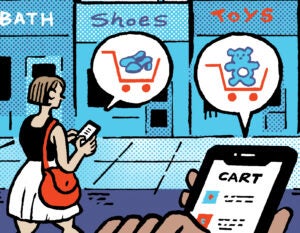 “Data-Driven Thinking” is written by members of the media community and contains fresh ideas on the digital revolution in media.
“Data-Driven Thinking” is written by members of the media community and contains fresh ideas on the digital revolution in media.
Today’s column is written by Jeremy Fain, co-founder and CEO at Cognitiv.
In a time where big holding companies are expecting all buying to go programmatic – Dentsu is the latest – it is more important than ever that advertisers not only own their data, but actually be in possession of it. Many advertisers may not realize that ownership is not enough or what the difference is.
The benefits of data possession in today’s world of big data cannot be discounted. Without data possession, the advertiser cannot take full advantage of its most valuable asset and, therefore, cannot compete against those who have already learned this lesson.
Owning and possessing data are two very different things. Owning data means you have control over how the data is used. Possessing data means you can use all of the data to get a full view of everything you own across disparate partners. This holistic data set, including advertising campaign results, site visits and customer data, is already helping the most advanced advertisers drive big improvements in ROI. For those not yet centralizing this detailed data, it is lying around in pieces and produces limited understanding and suboptimal ROI.
For years, advertisers have given permission to ad tech partners, such as demand-side platforms (DSPs) and data management platforms (DMPs), to safely collect and use data on their behalf. Programmatic advertising’s healthy ad tech ecosystem has created incredibly detailed and diverse data on every ad impression and user. This data, however, tends to be siloed.
Where the ad ran, how much it cost, information about the user it was shown to, viewability scores – all these pieces of data are generally possessed by different ad tech partners. New best-of-breed solutions are popping up every day, so this situation is likely to continue for a while. Since all of this data is contractually owned by the advertiser, the advertiser is the only one that has the right to take possession of it all and join it together into an incredibly rich, deep data asset.
As a first step toward data possession, advertisers should begin saving the last six months of historical data from their partners at the most granular level possible – hopefully at the impression or user level.
But what is an advertiser supposed to do with all this data? Today, the beauty is that an advertiser does not have to do anything with it. The marketing and ad tech ecosystem has many uses for this data already and teams of data scientists champing at the bit to get access to it.
An advertiser’s central warehouse can cost minimal amounts of money relative to overall marketing budgets. Even if the “warehouse” is only a collection of raw log files and downloads from vendors, it can serve as the source for improved decisioning, insights and strategies. It can also serve as a sandbox for those at the agency or advertiser as well as valuable third-party partners to experiment with new analysis, research and technology.
It seems like digital advertising evolves every six months. Cross-device targeting and attribution is no longer science fiction. Native advertising and dynamic creative are delivering improved, personalized calls to action. All of these new pieces of the advertising and marketing ecosystem are being driven by data – and they will drive even better results for the advertiser if they have a more comprehensive data set.
Follow Cognitiv (@TeamCognitiv) and AdExchanger (@adexchanger) on Twitter.












